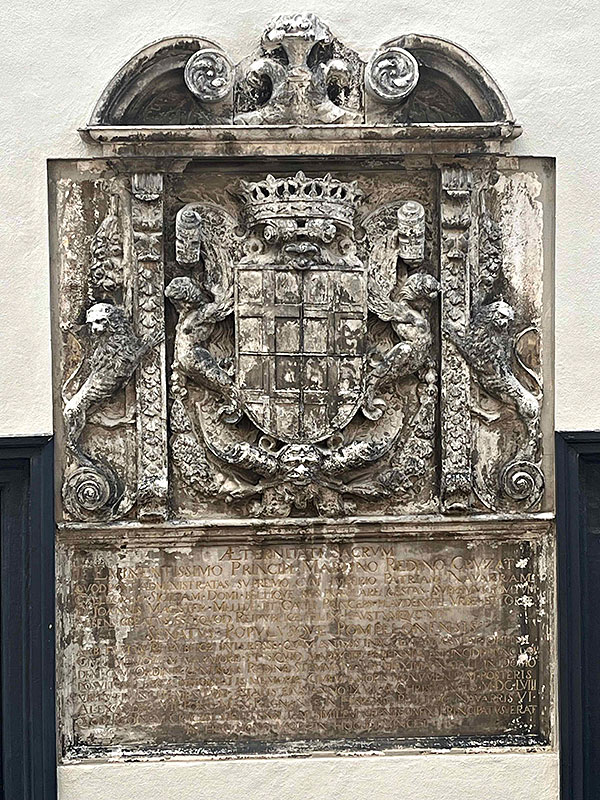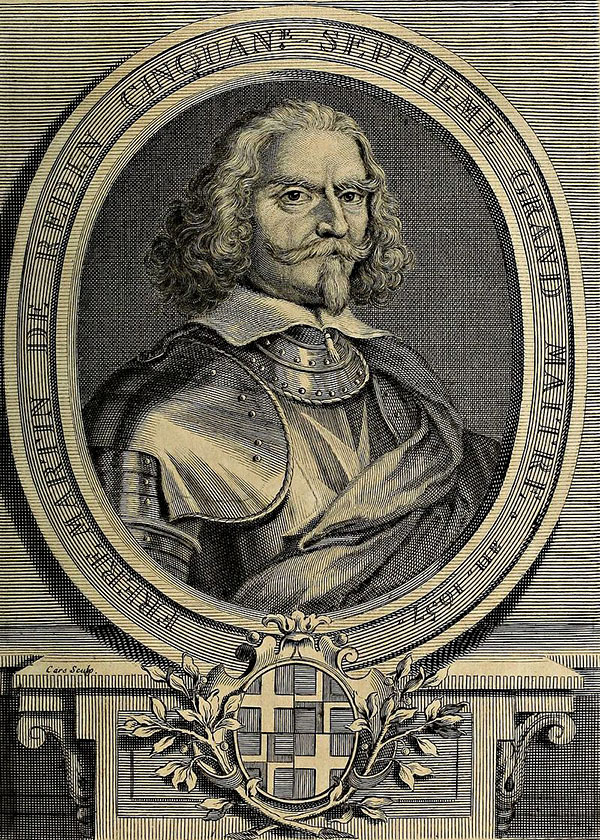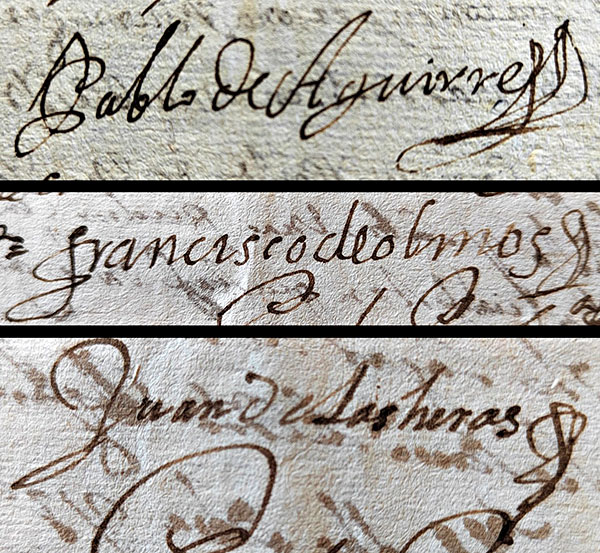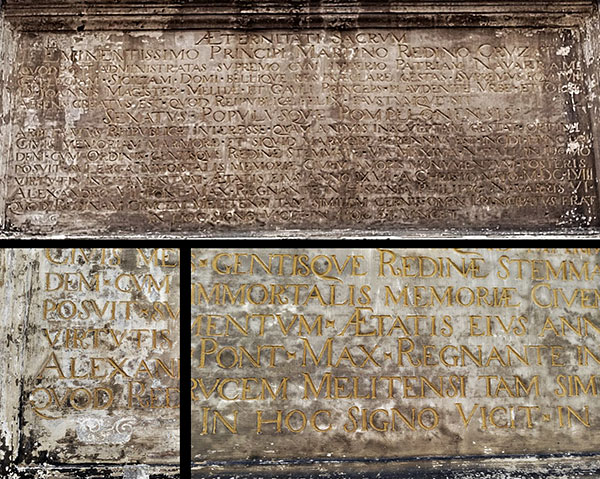The piece of the month of October 2024
THE COAT OF ARMS OF THE GRAND MASTER OF THE ORDER OF MALTA IN PAMPLONA, BAROQUE WORK BY THE SCULPTOR PABLO DE AGUIRRE
Pedro Luis Echeverría Goñi
University of the Basque Country
The old quarter of Pamplona still preserves about a hundred stone coats of arms, although another forty that existed at the beginning of the 20th century have disappeared, according to J. J. Martinena. We owe it to this historian to catalogue them by streets, which facilitates the enquiry, consigning in his case the sentences of nobility of the second half of the seventeenth century. Therefore, we are before a great set of pieces of the Baroque and Rococo in a moment of splendor that Caro Baroja denominated "the Navarrese hour" of the XVIII century. There are few programs of study on coats of arms that include documentation and typological analysis, specifically dedicated to the heraldic and historical commentary of the lineages. This is the case of the object of this study, the early and showy coat of arms that presides over the house of Martín de Redín y Cruzat, today a social and cultural community center (31 Mayor Street). Because of its orlature it has no parallel in the city other than those of García-Herreros y Leoz (Mercaderes, 3) and Vidarte-Ardaiz-Zaro-Aróstegui (place del Castillo, 2), both from the eighteenth century.

Martín de Redín y Cruzat's coat of arms and dedicatory tombstone. Photo: A. Hueso.
Biography of Don Frey Martín de Redín y Cruzat
This Navarrese nobleman and military man was the most prominent member of the illustrious family of his surname that had supported the Agramontese side. In spite of this, his entire degree program is developed in the service and with the support of Philip IV, known as the Planet King. In addition, his biography is closely linked to the Sovereign and Military Hospitaller Order of St. John of Jerusalem of Rhodes and Malta, of great implantation in Navarre, of which two of his uncles had been priors. After having been Grand Prior of the San Juanists of Navarre (1632-1652), the aforementioned monarch named him Viceroy of Sicily in 1656, degree scroll , which facilitated his election the following year as Grand Master of the Order.

J. F. Cars. Engraving by Martín de Redín (Abbé Vertot, Histoire des chevaliers hospitaliers de S. Jean de Jerusalem) CC0 1.0.
He held positions of royal appointment, such as field master in Navarre and Catalonia, commissioner of fortifications and captain general in Galicia. He stood out as a promoter in the art of poliorcetica, that is, the construction of fortresses. Thus we know that he reinforced the upper part of the northern front and the bastion of Redín, erected in 1540, in the walled enclosure of Pamplona. But he particularly carried out defensive works in Malta, such as the walls of Mdina, one of whose bastions of the land front, called Redín, reminds us of his tireless construction work. He also sponsored the construction of thirteen watchtowers on the coast, connected to each other, to prevent attacks by the Ottoman fleet.
The shield. Documentary genesis
To commemorate the appointment of Martín de Redin as Grand Master of the Order on August 18, 1657 and his ratification by Pope Alexander VII, in 1659 the Pamplona City Council commissioned the sculptor Pablo de Aguirre to execute a stone shield with his commemorative legend. Made in Asiáin and placed on the front of the main house on Calle Mayor, the sculptor died two days after dictating his will on September 23 of that same year, having received only 1,000 reales on account and without having seen his work appraised. For this reason, his widow and heir María de Orella filed a lawsuit in 1660 before the Court against the consistory, claiming its appraisal and payment. The appraisal was made at position in 1661 by Miguel de Labayen and Clemente de Quintana, sculptors from Pamplona and Asiáin, appointed by the regiment and the widow respectively, who fixed its value at 241 ducats and 7 reales. The second, a native of Isla, had worked in 1655 as a journeyman in Aguirre's workshop. The resistance of the patrons to pay this amount was based on the fact that the work was not worth more than 1,000 reales and the sculptor had been satisfied. In addition, according to the declaration of the councilors, the price of the stones, their cutting and transport to the house-workshop, as well as the placement of the shield, once carved, on the façade, were paid with municipal funds.

Autograph signatures of the sculptor Pablo de Aguirre, the architect Francisco de Olmos II and the painter Juan de las Heras II.
The architects Francisco de Olmos and Pascual Ochoa de Olza and the painter Juan de las Heras II, neighbors of Asiáin, testified for the sculptor. From them we know that it was the alderman Martín Cruzat and the secretary Diego de Zudaire who, together with the painter Juan de Bellostas, went to the town to pay him the 1,000 reales and that Aguirre was not satisfied with that amount, going several times to Pamplona to ask for his appraisal. Francisco de Olmos II affirms in his proof "to have worked on the said stones and weapons for many days". This long-lived assembler (1606-1687) followed the official document of his father of the same name, who, coming from Lérida, had established his workshop in Asiáin, as documented by J. Músquiz. Better trained than his progenitor, he became a prolific author of classicist altarpieces, with his friend Pablo de Aguirre collaborating as a sculptor in several of them. Juan de las Heras II(c. 1615-1676), biographed by Jimeno Jurío, was a member of the family workshop, becoming overseer of painting works for the bishopric of Pamplona, and may have been in charge of the polychromy of this armorial stone.
We find an exceptional contemporary description of this coat of arms in the joint declaration of the stonemasons of Pamplona, Juan de Areso, Domingo and Juan de Barrendegui, and Juan de Aurquía, made in 1661 at the request of the local regiment. In it they specify that "the said arms are of white stone and that they are three rods and average in height, two rods and average in width, and on the sides they have two lions and two angels, two breastplates, the shield and its crown, and at the top of the said arms, in the middle of the frontispiece, a well worked scepter like all the other arms expressed and that they have a sign at the bottom on a stone, also very well carved, with seven hundred and seventeen large letters". The shield with its frame measures c. 180 x cm, and the tombstone, 190 x cm. They valued this work and the conscientious work of sculpture and architecture carried out at 210 ducats, "because the work he had in carving them was very great, and also included in this amount was the sign that, as mentioned, is at the foot of the said arms". Although this estimate was below the work done, it implicitly recognizes its quality.

registration commemorative. Polychrome details. Photo: P. Echeverría.
The commemorative tombstone with molded framework contains a laudatory text in Latin with fifteen lines, which must have been written by the Jesuit José Moret, a great Latinist and the first chronicler of the Kingdom, as Martinena has proposed. Its transcription and translation appear in Pampilona, urbs regia. We must remember that Martín de Redin himself had commissioned Moret to write a propagandistic book in Latin with his military exploits in the uprising against the French siege of Fuenterrabía, printed in Lyon in 1657. We also know from Aranda Ruiz that, in an exceptional way, the Pamplona city council celebrated the success of one of its most illustrious sons with various celebrations, which included steers and fountains of wine and water that were set up at the gates of the city.
Technical, stylistic and heraldic descriptions
From the first third of the 16th century until the end of the 18th century, there are documentary mentions of employment of "white and soft stone" in doorways, coats of arms, statues and tombs, extracted from quarries such as those of Olza, Olcoz, Guenduláin or Muru-Astráin. In 1661, the aforementioned stonemasons affirmed that "the said arms are made of white stone", most probably obtained from the limestone quarry of Alto de Arrobia (from harrobi: quarry), in the municipality of Olza. The materials used in the palaces of Olza, the Rococo coat of arms of the palace of Sarasa, the façade of the palace of the Marquis of Aguayo and those of the Marquis of Rozalejo in Pamplona and Subiza came from here. This unblemished stone also appears in the relief of the Assumption and the angels of the academic portico of the cathedral of Pamplona and in the monument to the Immaculate Conception of the Rincón de la Aduana. Like other stone coats of arms, the Grand Master's coat of arms was polychromed with its heraldic colors, still conserving the gilding of the capital letters of the registration and a decoration of scrolls on the lower part of the slab. It is in need of cleaning to remove the accumulated dirt and recover the color or, at least, the original whiteness of this stone.

Coat of arms of the Grand Master. Photo: P. Echeverría.
On a sill rises the architectural frame, with pilasters decorated in its cajeamiento with surmontadas leaves that seat and are finished off in foliaceous brackets. On a flown cornice we see a curved pediment divided in volutes, arranging in the middle a vase with fruits. Leaning on the volutes, two rampant lions are represented as tenants of the pilasters, embracing them with their right claws, which are opposed in the same attitude by the sinister ones; they turn their heads three-quarters to the front and show their tails raised. In heraldry, the lion is the image of the good military man, brave and noble, traits that characterized Don Martin de Redin. Let us remember that the Pamplona regiment, commissioner of this work, has a lion in its coat of arms, symbol of sovereignty, authority and magnificence, which was a concession of Carlos III the Noble to the city on the occasion of the Union of the burghs.
The coat of arms is mounted on a correiform cartouche with a scaled field at the bottom, characteristic of the 17th century. It presents crown by bell with rhomboidal stones and seven fleurs-de-lis. It has two upper and lower masks from whose mouths depart garlands of fruits. It is flanked as tenants by two angels with unfolded wings. The arms of Martín de Redín as Grand Master that are displayed in this shield quartered in cross are four crosses: 1 and 4 in field of gules, white cross of the Order of Malta; 2 and 3, of azure, cross quartered of gold and gules.
In the Latin registration that exalts the illustrious knight from Pamplona, Father Moret included the following phrase: "The great similarity that you distinguish between the cross of Redín and that of Malta was an omen of his principality. In this sign he conquered, in this sign he will conquer" (according to the translation of J. Ayesa and J. A. Goñi). In the triumphal rhetoric of the Counter-Reformation the presence of the heraldic piece of the cross as a common weapon of the lineage and of the Order over which he presided is highlighted here, concluding with the famous phrase of the Vision of Constantine that propitiated the victory in the battle of Milvian Bridge over Maxentius and the substitution of the pagan empire by another Christian and universal one.
SOURCES AND BIBLIOGRAPHY
file General of Navarra. Proceedings, 135341.
MARTINENA RUIZ, J. J., Escudos de armas en las calles de Pamplona, Pamplona, Pamplona, Pamplona City Council, 1997, p. 64. Coat of arms no. 42.
ARANDA RUIZ, A., Pampilona, urbs regia. El ceremonial del Ayuntamiento de Pamplona desde el siglo XVII hasta nuestros días, Pamplona, Ayuntamiento de Pamplona, 2021, pp. 329-331, grade 1534.
FLORISTÁN "Martín de Redín", in Spanish Biographical Dictionary. Royal Academy of History.
